Modeling Ozone Source Apportionment and Performing Sensitivity Analysis in Summer on the North China Plain
Abstract
1. Introduction
2. Experiments
2.1. Model Description and Setup
2.2. Emission Inventory
2.3. Source Apportionment
2.4. Model Evaluation
2.5. Indicator of Ozone-Sensitivity Regime
3. Results
3.1. Spatial Distribution of the Simulated Ozone
3.2. Analysis of Ozone Source Apportionment
3.2.1. O3 Source Apportionments for 13 Cities on the NCP
3.2.2. Diurnal Variation in O3 Source Apportionments at 6 Sites in the NCP Region
3.3. Ozone Sensitivity Analysis
3.3.1. Ozone Sensitivity Analysis over the NCP
3.3.2. Ozone Net Production Analysis over the NCP
3.4. Contributions of Biological Sources
4. Conclusions
Author Contributions
Funding
Acknowledgments
Conflicts of Interest
References
- Crutzen, P. A discussion of the chemistry of some minor constituents in the stratosphere and troposphere. Pure Appl. Geophys. PAGEOPH 1973, 106, 1385–1399. [Google Scholar] [CrossRef]
- Levy, H. Normal Atmosphere: Large Radical and Formaldehyde Concentrations Predicted. Science 1971, 173, 141–143. [Google Scholar] [CrossRef] [PubMed]
- Danielsen, E.F. Stratospheric-Tropospheric Exchange Based on Radioactivity, Ozone and Potential Vorticity. J. Atmos. Sci. 1968, 25, 502–518. [Google Scholar] [CrossRef]
- IPCC. Fifth Assessment Report: Climate Change 2013; Inter Governmental Panel on Climate Change: Geneva, Switzerland, 2013. [Google Scholar]
- Gryparis, A.; Forsberg, B.; Katsouyanni, K.; Analitis, A.; Touloumi, G.; Schwartz, J.; Samoli, E.; Medina, S.; Anderson, H.R.; Niciu, E.M.; et al. Acute Effects of Ozone on Mortality from the “Air Pollution and Health”. Am. J. Respir. Crit. Care Med. 2004, 170, 1080–1087. [Google Scholar] [CrossRef]
- Bignal, K.L.; Ashmore, M.R.; Headley, A.D.; Stewart, K.; Weigert, K. Ecological impacts of air pollution from road transport on local vegetation. Appl. Geochem. 2007, 22, 1265–1271. [Google Scholar] [CrossRef]
- Agrawal, M.; Singh, B.; Rajput, M.; Marshall, F.; Bell, J.N.B. Effect of air pollution on peri-urban agriculture: A case study. Environ. Pollut. 2003, 126, 323–329. [Google Scholar] [CrossRef]
- Avnery, S.; Mauzerall, D.L.; Liu, J.; Horowitz, L.W. Global crop yield reductions due to surface ozone exposure: 2. Year 2030 potential crop production losses and economic damage under two scenarios of O3 pollution. Atmos. Environ. 2011, 45, 2297–2309. [Google Scholar] [CrossRef]
- Monks, P.S.; Archibald, A.T.; Colette, A.; Cooper, O.; Coyle, M.; Derwent, R.; Fowler, D.; Granier, C.; Law, K.; Mills, G.; et al. Tropospheric ozone and its precursors from the urban to the global scale from air quality to short-lived climate forcer. Atmos. Chem. Phys. Discuss. 2015, 15, 8889–8973. [Google Scholar] [CrossRef]
- Wang, Y.; Shen, L.; Wu, S.; Mickley, L.; He, J.; Hao, J. Sensitivity of surface ozone over China to 2000–2050 global changes of climate and emissions. Atmos. Environ. 2013, 75, 374–382. [Google Scholar] [CrossRef]
- Fang, X.-Z.; Xiao, H.-Y.; Sun, H.; Liu, C.; Zhang, Z.-Y.; Xie, Y.-J.; Liang, Y.; Wang, F. Characteristics of Ground-Level Ozone from 2015 to 2018 in BTH Area, China. Atmosphere 2020, 11, 130. [Google Scholar] [CrossRef]
- Wang, W.-N.; Cheng, T.; Gu, X.-F.; Chen, H.; Guo, H.; Wang, Y.; Bao, F.-W.; Shi, S.-Y.; Xu, B.-R.; Zuo, X.; et al. Assessing Spatial and Temporal Patterns of Observed Ground-level Ozone in China. Sci. Rep. 2017, 7, 3651. [Google Scholar] [CrossRef] [PubMed]
- Wang, Y.; Konopka, P.; Liu, Y.; Chen, H.; Muller, R.; Plöger, F.; Riese, M.; Cai, Z.; Lu, D. Tropospheric ozone trend over Beijing from 2002–2010: Ozonesonde measurements and modeling analysis. Atmos. Chem. Phys. Discuss. 2012, 12, 11175–11199. [Google Scholar] [CrossRef]
- Han, X.; Zhu, L.; Wang, S.; Meng, X.; Zhang, M.; Hu, J. Modeling study of impacts on surface ozone of regional transport and emissions reductions over North China Plain in summer 2015. Atmos. Chem. Phys. Discuss. 2018, 18, 12207–12221. [Google Scholar] [CrossRef]
- Gao, M.; Gao, J.; Zhu, B.; Kumar, R.; Lu, X.; Song, S.; Zhang, Q.; Jia, B.; Wang, P.; Beig, G.; et al. Ozone pollution over China and India: Seasonality and sources. Atmos. Chem. Phys. Discuss. 2020, 20, 4399–4414. [Google Scholar] [CrossRef]
- Xu, J.; Zhang, Y.H.; Fu, J.S.; Zheng, S.; Wang, W. Process analysis of typical summertime ozone episodes over the Beijing area. Sci. Total Environ. 2008, 399, 147–157. [Google Scholar] [CrossRef]
- Duan, J.; Tan, J.; Yang, L.; Wu, S.; Hao, J. Concentration, sources and ozone formation potential of volatile organic compounds (VOCs) during ozone episode in Beijing. Atmos. Res. 2008, 88, 25–35. [Google Scholar] [CrossRef]
- Tang, G.; Wang, Y.; Li, X.; Ji, D.; Hsu, S.; Gao, X. Spatial-temporal variations in surface ozone in Northern China as observed during 2009–2010 and possible implications for future air quality control strategies. Atmos. Chem. Phys. Discuss. 2012, 12, 2757–2776. [Google Scholar] [CrossRef]
- Wang, H.; Wu, Q.Z.; Liu, H.; Wang, Y.; Cheng, H.; Wang, R.; Wang, L.; Xiao, H.; Yang, X. Sensitivity of biogenic volatile organic compound emissions to leaf area index and land cover in Beijing. Atmos. Chem. Phys. Discuss. 2018, 18, 9583–9596. [Google Scholar] [CrossRef]
- Mo, Z.; Shao, M.; Wang, W.; Liu, Y.; Wang, M.; Lu, S. Evaluation of biogenic isoprene emissions and their contribution to ozone formation by ground-based measurements in Beijing, China. Sci. Total Environ. 2018, 627, 1485–1494. [Google Scholar] [CrossRef]
- Phillips, N.A. A coordinate system having some special advantages for numerical forecasting. J. Meteorol. 1957, 14, 184–185. [Google Scholar] [CrossRef]
- Zaveri, R.; Peters, L.K. A new lumped structure photochemical mechanism for large-scale applications. J. Geophys. Res. Space Phys. 1999, 104, 30387–30415. [Google Scholar] [CrossRef]
- Nenes, A.; Pandis, S.N.; Pilinis, C. ISORROPIA: A New Thermodynamic Equilibrium Model for Multiphase Multicomponent Inorganic Aerosols. Aquat. Geochem. 1998, 4, 123–152. [Google Scholar] [CrossRef]
- Odum, J.R.; Jungkamp, T.P.W.; Griffin, R.J.; Flagan, R.C.; Seinfeld, J.H. The Atmospheric Aerosol-Forming Potential of Whole Gasoline Vapor. Science 1997, 276, 96–99. [Google Scholar] [CrossRef] [PubMed]
- Li, J.; Wang, Z.; Wang, X.; Yamaji, K.; Takigawa, M.; Kanaya, Y.; Pochanart, P.; Liu, Y.; Irie, H.; Hu, B.; et al. Impacts of aerosols on summertime tropospheric photolysis frequencies and photochemistry over Central Eastern China. Atmos. Environ. 2011, 45, 1817–1829. [Google Scholar] [CrossRef]
- Li, J.; Wang, Z.; Zhuang, G.; Luo, G.; Sun, Y.; Wang, Q. Mixing of Asian mineral dust with anthropogenic pollutants over East Asia: A model case study of a super-duststorm in March 2010. Atmos. Chem. Phys. Discuss. 2012, 12, 7591–7607. [Google Scholar] [CrossRef]
- Walcek, C.J.; Aleksic, N.M. A simple but accurate mass conservative, peak-preserving, mixing ratio bounded advection algorithm with FORTRAN code. Atmos. Environ. 1998, 32, 3863–3880. [Google Scholar] [CrossRef]
- Wesely, M. Parameterization of surface resistances to gaseous dry deposition in regional-scale numerical models. Atmos. Environ. 1989, 23, 1293–1304. [Google Scholar] [CrossRef]
- Skamarock, W.C.; Klemp, J.B.; Dudhia, J.; Gill, D.O.; Barker, D.M.; Duda, M.G.; Huang, X.Y.; Wang, W.; Powers, J.G. A Description of the Advanced Research WRF Version 3. NCAR/TN–475+STR NCAR TECHNICAL NOTE. 2008. Available online: https://www.researchgate.net/publication/306154004_A_Description_of_the_Advanced_Research_WRF_Version_3 (accessed on 3 September 2020).
- Zhang, Q.; Streets, D.G.; Carmichael, G.R.; He, K.B.; Huo, H.; Kannari, A.; Klimont, Z.; Park, I.S.; Reddy, S.; Fu, J.S.; et al. Asian emissions in 2006 for the NASA INTEX-B mission. Atmos. Chem. Phys. 2019, 9, 5131–5153. [Google Scholar] [CrossRef]
- Calfapietra, C.; Fares, S.; Manes, F.; Morani, A.; Sgrigna, G.; Loreto, F. Role of Biogenic Volatile Organic Compounds (BVOC) emitted by urban trees on ozone concentration in cities: A review. Environ. Pollut. 2013, 183, 71–80. [Google Scholar] [CrossRef]
- Li, J.; Wang, Z.; Akimoto, H.; Yamaji, K.; Takigawa, M.; Pochanart, P.; Liu, Y.; Tanimoto, H.; Kanaya, Y. Near-ground ozone source attributions and outflow in central eastern China during MTX2006. Atmos. Chem. Phys. Discuss. 2008, 8, 7335–7351. [Google Scholar] [CrossRef]
- Wu, J.-B.; Wang, Z.; Wang, Q.; Li, J.; Xu, J.; Chen, H.; Ge, B.; Zhou, G.; Chang, L. Development of an on-line source-tagged model for sulfate, nitrate and ammonium: A modeling study for highly polluted periods in Shanghai, China. Environ. Pollut. 2017, 221, 168–179. [Google Scholar] [CrossRef] [PubMed]
- Li, J.; Nagashima, T.; Kong, L.; Ge, B.; Yamaji, K.; Fu, J.S.; Wang, X.; Fan, Q.; Itahashi, S.; Lee, H.-J.; et al. Model evaluation and intercomparison of surface-level ozone and relevant species in East Asia in the context of MICS-Asia Phase III—Part 1: Overview. Atmos. Chem. Phys. Discuss. 2019, 19, 12993–13015. [Google Scholar] [CrossRef]
- Akimoto, H.; Nagashima, T.; Li, J.; Fu, J.S.; Ji, D.; Tan, J.; Wang, Z. Comparison of surface ozone simulation among selected regional models in MICS-Asia III—Effects of chemistry and vertical transport for the causes of difference. Atmos. Chem. Phys. Discuss. 2019, 19, 603–615. [Google Scholar] [CrossRef]
- Sillman, S. The relation between ozone, NOx and hydrocarbons in urban and polluted rural environments. Atmos. Environ. 1999, 33, 1821–1845. [Google Scholar] [CrossRef]
- Hu, J.; Li, Y.; Zhao, T.; Liu, J.; Hu, X.-M.; Liu, D.; Jiang, Y.; Xu, J.; Chang, L. An important mechanism of regional O3 transport for summer smog over the Yangtze River Delta in eastern China. Atmos. Chem. Phys. Discuss. 2018, 18, 16239–16251. [Google Scholar] [CrossRef]
- Sillman, S.; He, N.; Cardelino, C.; Imhoff, R.E. The Use of Photochemical Indicators to Evaluate Ozone-NOx-Hydrocarbon Sensitivity: Case Studies from Atlanta, New York, and Los Angeles. J. Air Waste Manag. Assoc. 1997, 47, 1030–1040. [Google Scholar] [CrossRef]
- Tonnesen, G.S.; Dennis, R.L. Analysis of radical propagation efficiency to assess ozone sensitivity to hydrocarbons and NOx: 1. Local indicators of instantaneous odd oxygen production sensitivity. J. Geophys. Res. Space Phys. 2000, 105, 9213–9225. [Google Scholar] [CrossRef]
- Jiménez, P.; Baldasano, J.M. Ozone response to precursor controls in very complex terrains: Use of photochemical indicators to assess O3-NOx-VOC sensitivity in the northeastern Iberian Peninsula. J. Geophys. Res. Space Phys. 2004, 109, 109. [Google Scholar] [CrossRef]
- Sillman, S.; Odman, M.T.; Russell, A.G. Comment on “On the indicator-based approach to assess ozone sensitivities and emissions features” by Cheng-Hsuan Lu and Julius, S. Chang. J. Geophys. Res. Space Phys. 2001, 106, 20941–20944. [Google Scholar] [CrossRef]
- Sillman, S. The Use of NOy, H2O2 and HNO3 as Indicators for the O3-NOx-VOC Sensitivity in Urban Locations. J. Geophys. Res. 1995, 100, 14175–14188. [Google Scholar] [CrossRef]
- O’Connor, F.M.; Law, K.S.; Pyle, J.A.; Barjat, H.; Brough, N.; Dewey, K.; Green, T.; Kent, J.; Phillips, G. Tropospheric ozone budget: Regional and global calculations. Atmos. Chem. Phys. Discuss. 2004, 4, 991–1036. [Google Scholar] [CrossRef]
- Liu, Y.; Li, L.; An, J.; Huang, L.; Yan, R.; Huang, C.; Wang, H.; Wang, Q.; Wang, M.; Zhang, W. Estimation of biogenic VOC emissions and its impact on ozone formation over the Yangtze River Delta region, China. Atmos. Environ. 2018, 186, 113–128. [Google Scholar] [CrossRef]
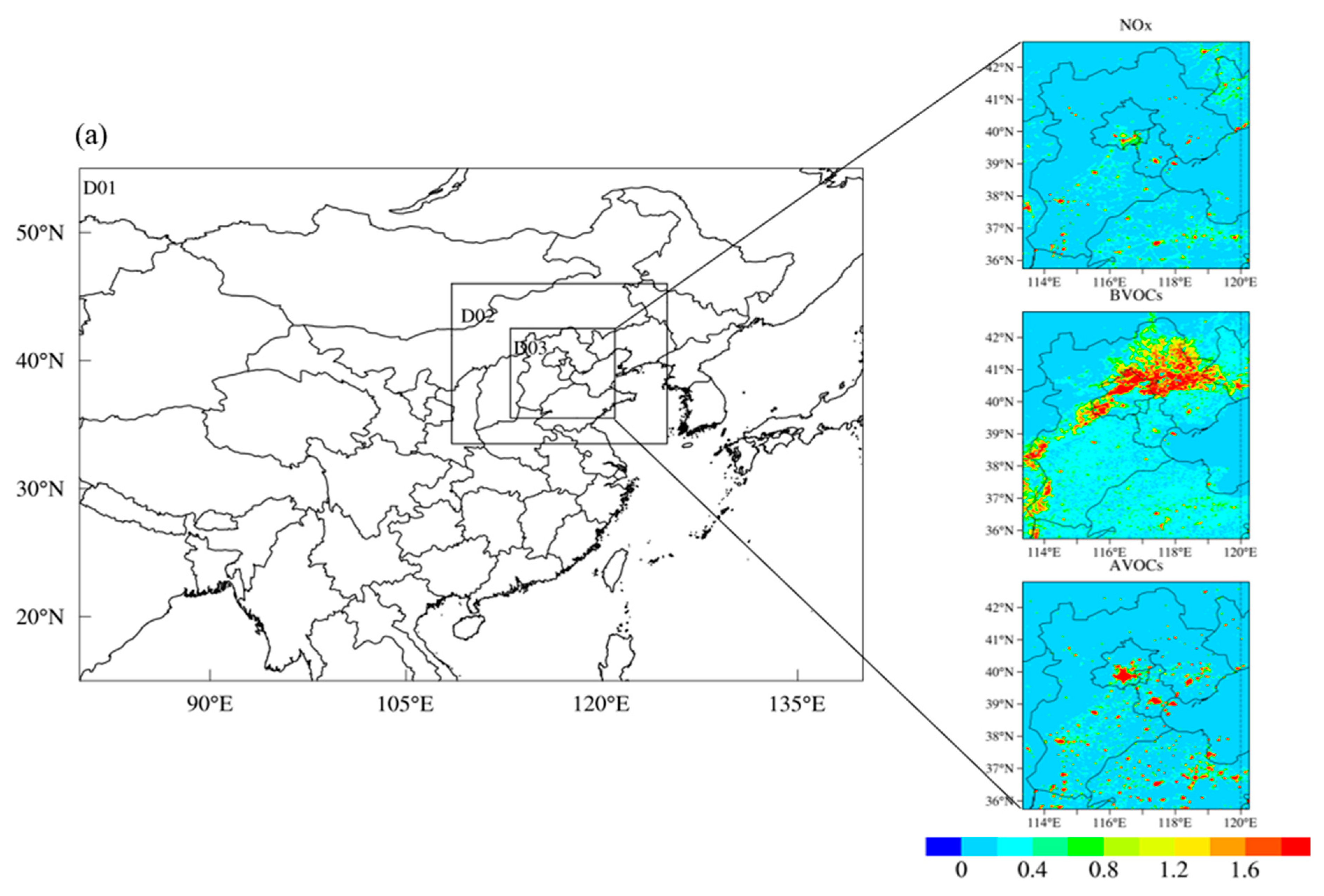
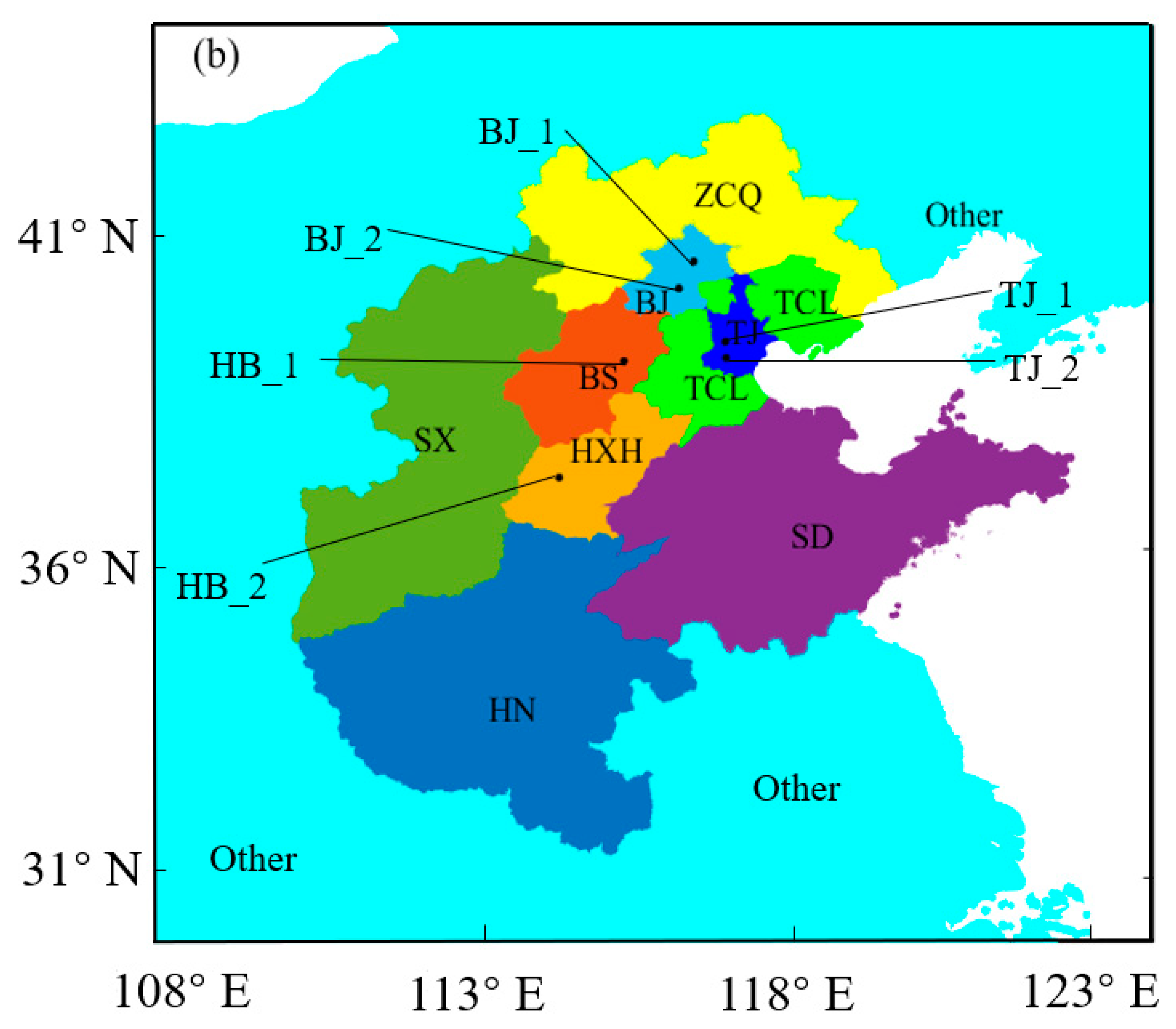
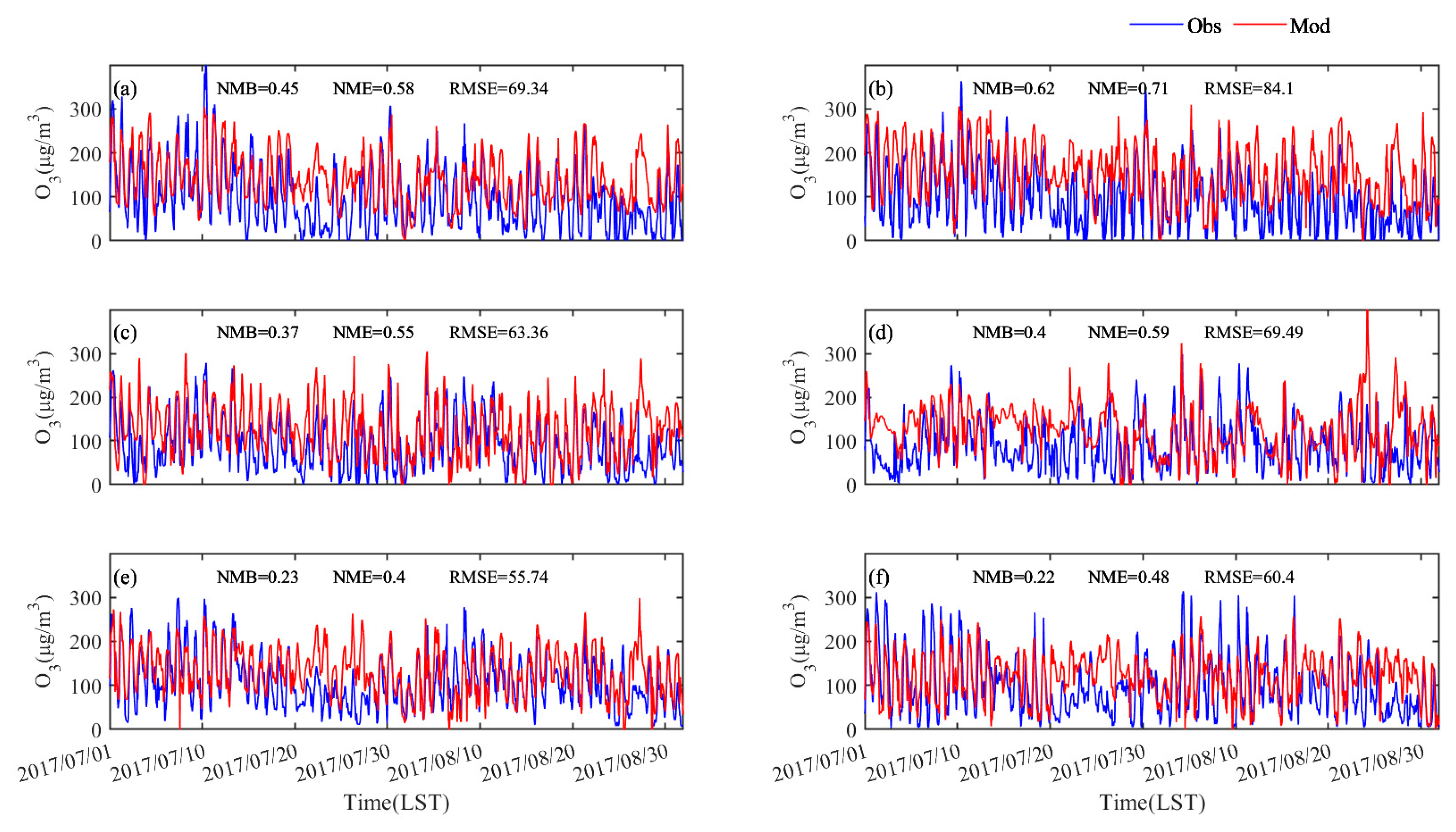
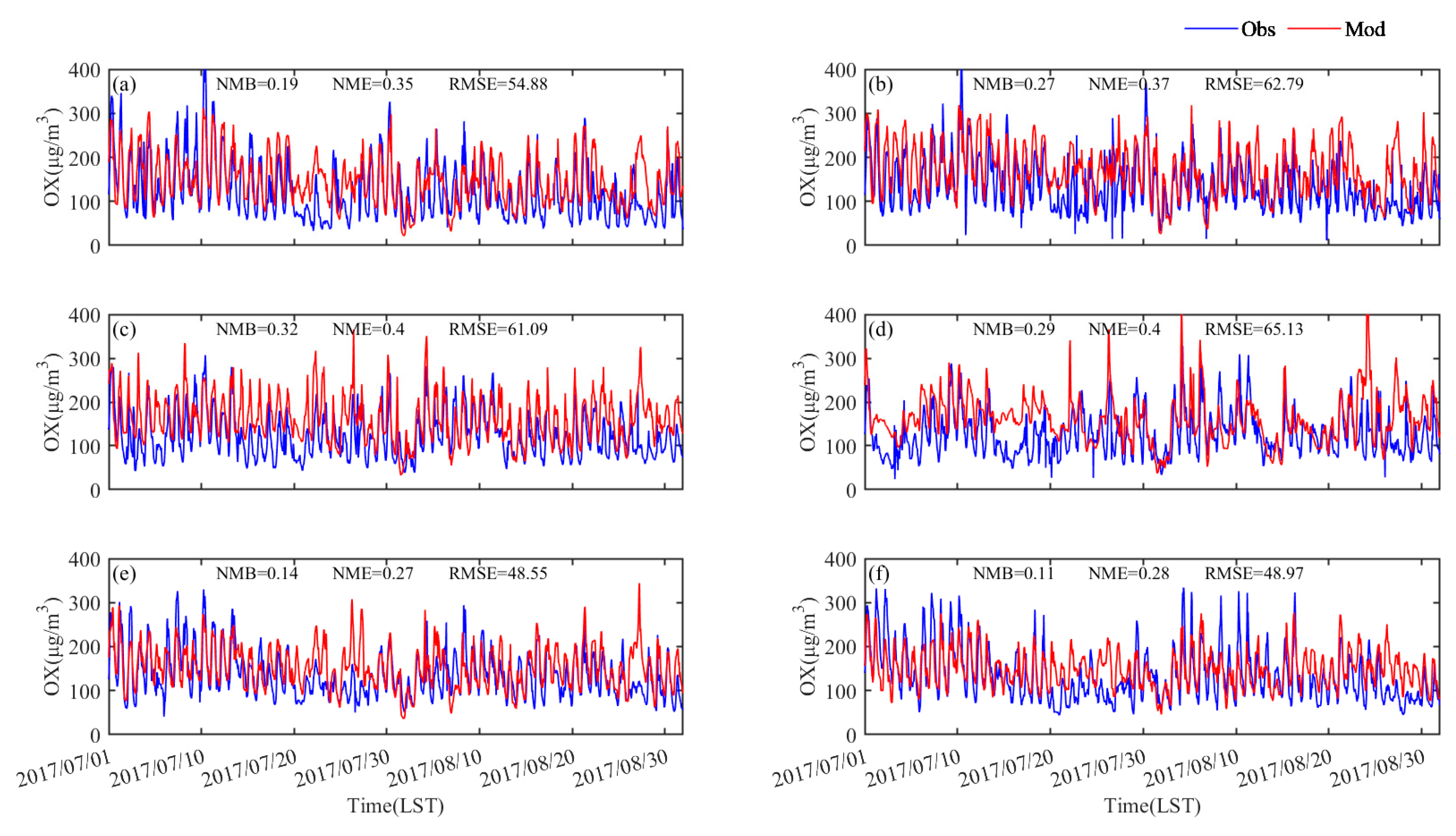
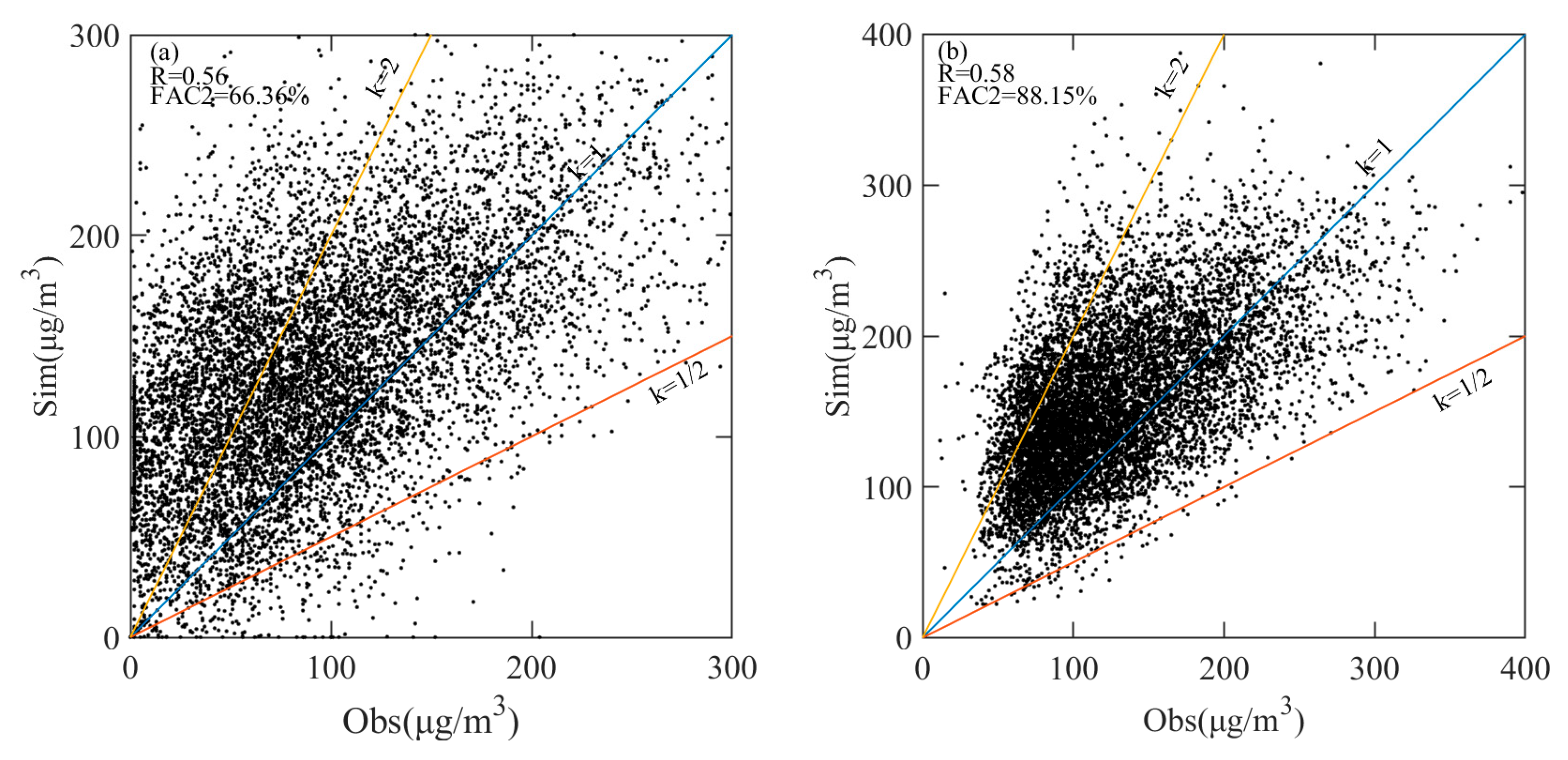


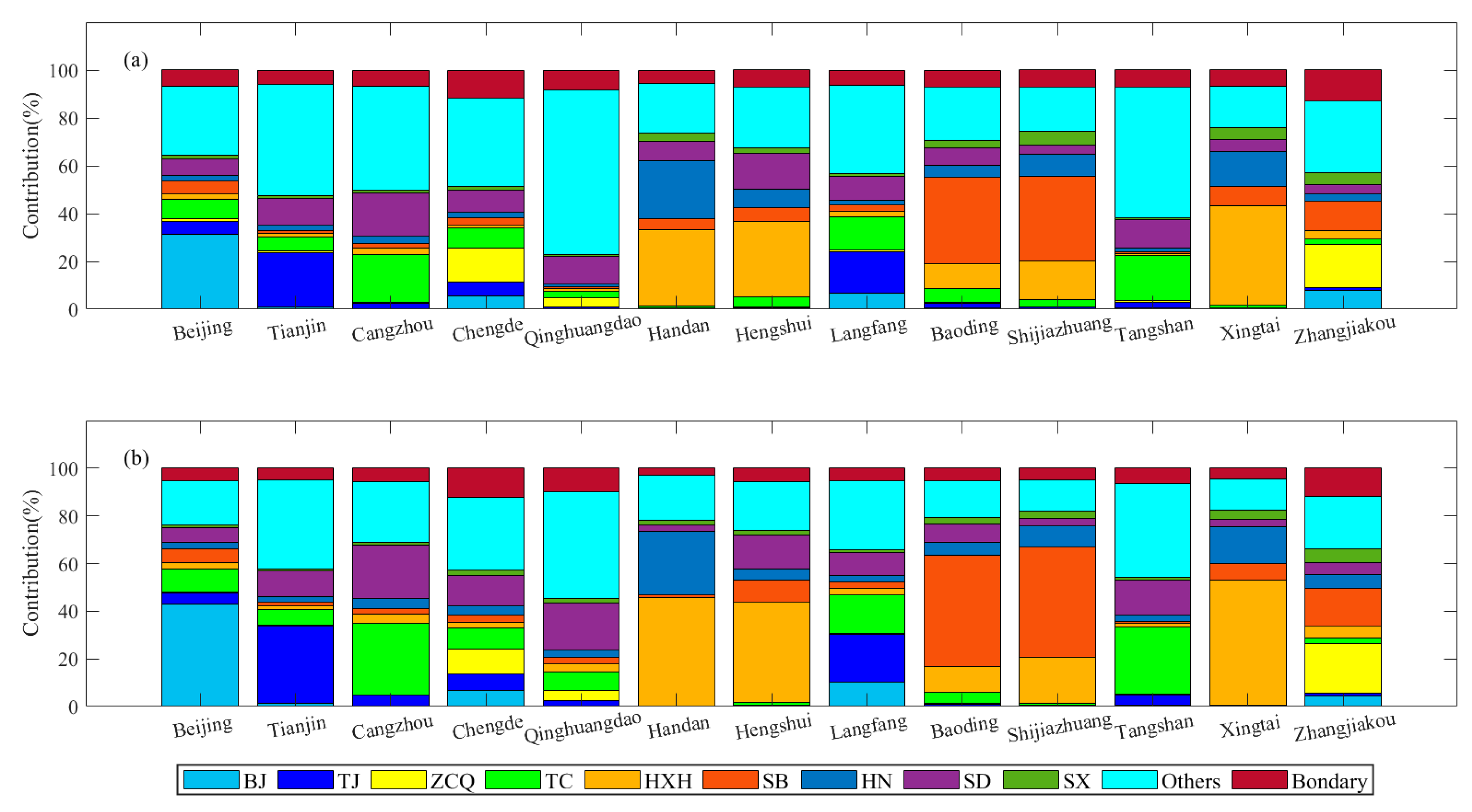
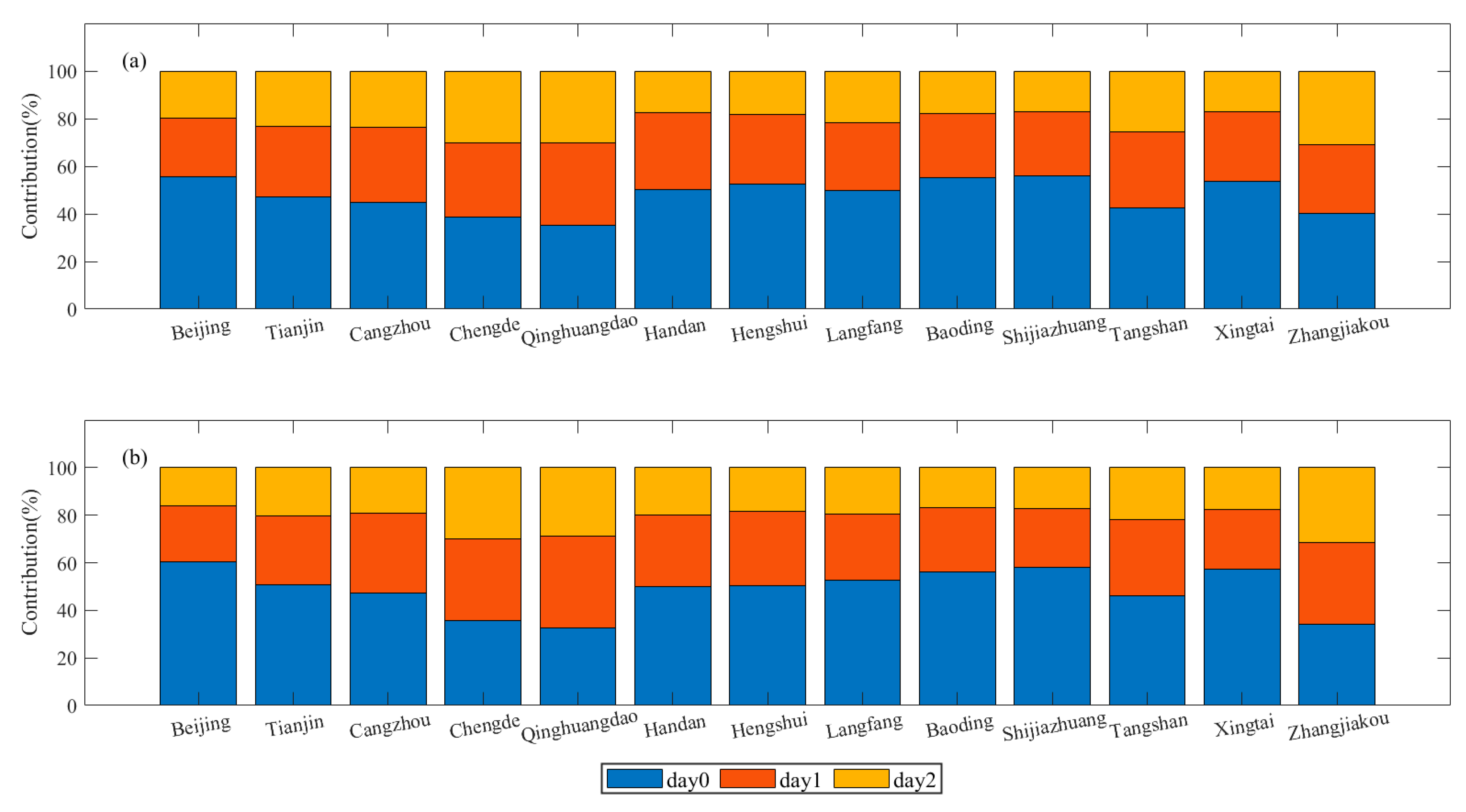



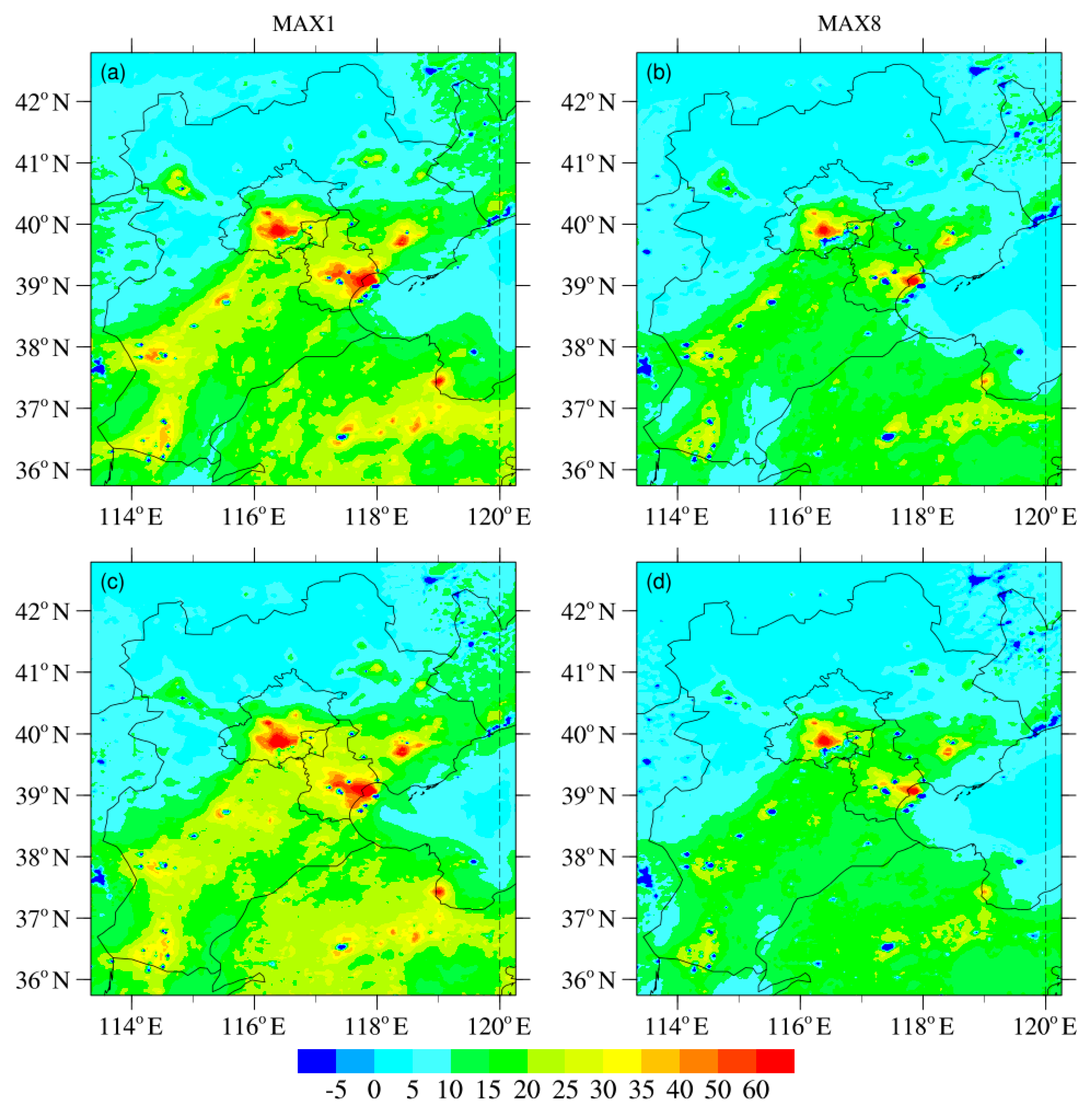
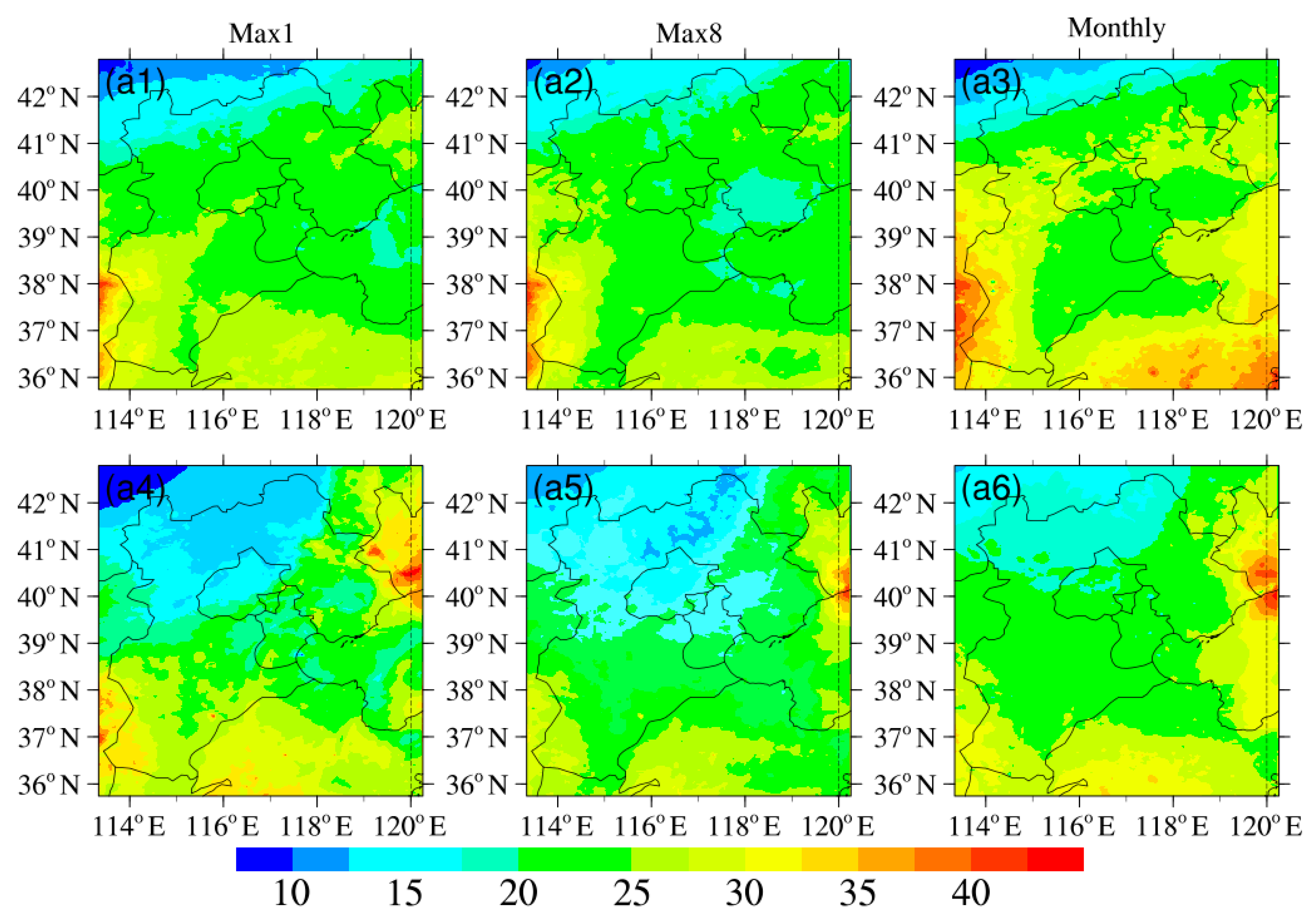
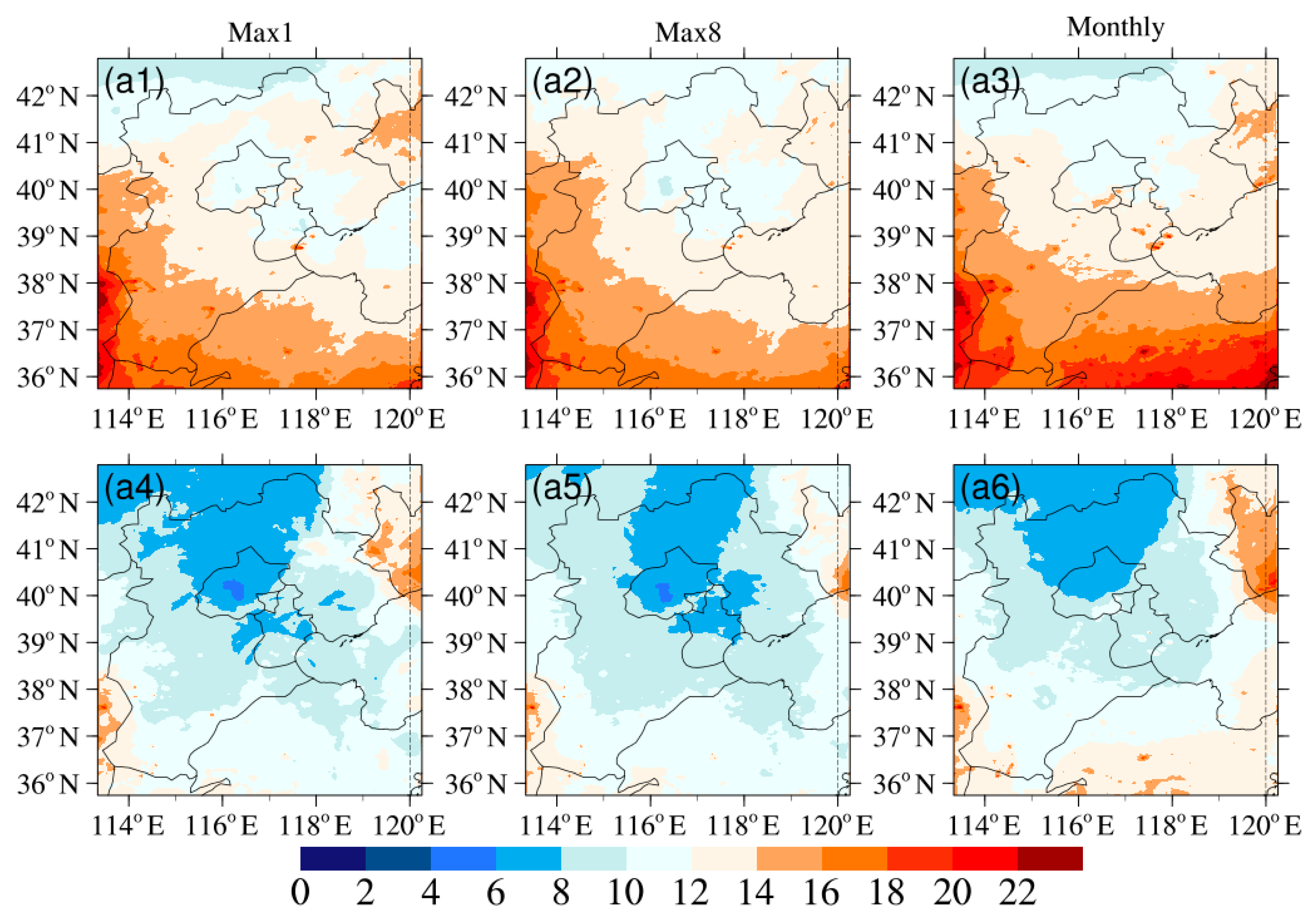
| Station | Longitude (°E) | Latitude (°N) | R | MO | MP (°C) | MB (°C) | RMSE | NMB (%) |
|---|---|---|---|---|---|---|---|---|
| Beijing | 116.28 | 39.93 | 0.9 | 26.6 | 31.4 | 4.9 | 5.5 | 18.3 |
| Chaoyang | 116.48 | 39.95 | 0.9 | 27.1 | 31.2 | 4.1 | 4.2 | 15.3 |
| Haidian | 116.28 | 39.98 | 0.9 | 26.0 | 31.5 | 5.5 | 4.7 | 21.0 |
| Huairou | 116.63 | 40.32 | 0.9 | 25.5 | 30.3 | 4.7 | 5.7 | 18.5 |
| Changping | 116.22 | 40.22 | 0.9 | 26.3 | 31.0 | 4.6 | 5.4 | 17.6 |
| Shijingshan | 116.18 | 39.93 | 0.9 | 26.1 | 31.3 | 5.8 | 4.7 | 20.0 |
| NOX | VOCs | |
|---|---|---|
| Base | 100% | 100% |
| Case 1 | 50% | 100% |
| Case 2 | 100% | 50% |
© 2020 by the authors. Licensee MDPI, Basel, Switzerland. This article is an open access article distributed under the terms and conditions of the Creative Commons Attribution (CC BY) license (http://creativecommons.org/licenses/by/4.0/).
Share and Cite
Zhang, Y.; Zhao, Y.; Li, J.; Wu, Q.; Wang, H.; Du, H.; Yang, W.; Wang, Z.; Zhu, L. Modeling Ozone Source Apportionment and Performing Sensitivity Analysis in Summer on the North China Plain. Atmosphere 2020, 11, 992. https://doi.org/10.3390/atmos11090992
Zhang Y, Zhao Y, Li J, Wu Q, Wang H, Du H, Yang W, Wang Z, Zhu L. Modeling Ozone Source Apportionment and Performing Sensitivity Analysis in Summer on the North China Plain. Atmosphere. 2020; 11(9):992. https://doi.org/10.3390/atmos11090992
Chicago/Turabian StyleZhang, Yujing, Yuncheng Zhao, Jie Li, Qizhong Wu, Hui Wang, Huiyun Du, Wenyi Yang, Zifa Wang, and Lili Zhu. 2020. "Modeling Ozone Source Apportionment and Performing Sensitivity Analysis in Summer on the North China Plain" Atmosphere 11, no. 9: 992. https://doi.org/10.3390/atmos11090992
APA StyleZhang, Y., Zhao, Y., Li, J., Wu, Q., Wang, H., Du, H., Yang, W., Wang, Z., & Zhu, L. (2020). Modeling Ozone Source Apportionment and Performing Sensitivity Analysis in Summer on the North China Plain. Atmosphere, 11(9), 992. https://doi.org/10.3390/atmos11090992







